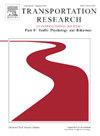是什么影响了电动滑板车的碰撞风险和碰撞发生率?一项自然主义骑行研究的见解
IF 3.5
2区 工程技术
Q1 PSYCHOLOGY, APPLIED
Transportation Research Part F-Traffic Psychology and Behaviour
Pub Date : 2025-06-01
DOI:10.1016/j.trf.2025.05.030
引用次数: 0
摘要
自然数据,即道路使用者在日常生活中收集的真实交通数据,是碰撞原因分析的黄金标准。事实上,这些数据可以显示车祸前道路使用者的行为,而这很难从其他车祸数据中观察到。在1.5年的时间里,从17辆电动滑板车上收集了4694名不同参与者的6868次旅行的自然数据,用于通过优势比(OR)和人口归因风险百分比(PARP)来估计碰撞风险。我们计算了OR和PARP,将碰撞和接近碰撞与正常骑行的基线事件进行比较。通过匹配和随机抽样策略选择基线,以扩大和增加先前结果的统计显著性,同时也为未来对坠机因果关系的研究提供新的方法见解。本研究还调查了不同基线与安全关键事件比率对碰撞风险评估的影响。从安全的角度来看,我们的研究结果表明,减少休闲旅行、十字路口暴露、周五和周六旅行、背包骑行和无经验骑行的安全干预措施应该优先考虑。从方法学的角度来看,我们展示了如何将随机基线和匹配基线相结合,以帮助量化微型机动车辆的碰撞风险和碰撞发生率。这项研究的结果可能会鼓励政策制定者在电动滑板车监管方面做出数据驱动的决策。未来的研究应该将自然主义研究和碰撞数据库的数据与其他道路使用者的数据结合起来,以提供一个更全面的电动滑板车安全性视图。本文章由计算机程序翻译,如有差异,请以英文原文为准。
What influences crash risk and crash prevalence for e-scootering? Insights from a naturalistic riding study
Naturalistic data, i.e. data collected in real traffic by road users attending their daily routines, are the gold standard for crash causation analyses. In fact, these data can show the pre-crash road-user behaviour that is hard to observe from other crash data. Naturalistic data from 6868 trips by 4694 distinct participants, collected over a period of 1.5 years from 17 e-scooters, were used to estimate crash risk by means of odds ratios (OR) and crash prevalence by population attributable risk percentage (PARP). We computed OR and PARP, comparing crashes and near-crashes to baseline events from normal riding. The baselines were selected through both matching and random sampling strategies in order to expand and increase the statistical significance of previous results—while also providing new methodological insights for future research on crash causation. This study also investigated the impact of different baseline–to–safety–critical event ratios for the assessment of crash risk.
From a safety perspective, our findings suggest that safety interventions that reduce leisure trips, exposure to intersections, trips on Fridays and Saturdays, pack riding, and inexperienced riding should be prioritised. From a methodological perspective, we showed how combining random and matched baselines can help quantify the crash risk and crash prevalence for micromobility vehicles. The results from this study may encourage policymakers to make data-driven decisions regarding e-scooter regulations. Future research should combine data from naturalistic studies and crash databases with data from the perspective of other road users to provide a more holistic view of e-scooter safety.
求助全文
通过发布文献求助,成功后即可免费获取论文全文。
去求助
来源期刊
CiteScore
7.60
自引率
14.60%
发文量
239
审稿时长
71 days
期刊介绍:
Transportation Research Part F: Traffic Psychology and Behaviour focuses on the behavioural and psychological aspects of traffic and transport. The aim of the journal is to enhance theory development, improve the quality of empirical studies and to stimulate the application of research findings in practice. TRF provides a focus and a means of communication for the considerable amount of research activities that are now being carried out in this field. The journal provides a forum for transportation researchers, psychologists, ergonomists, engineers and policy-makers with an interest in traffic and transport psychology.

 求助内容:
求助内容: 应助结果提醒方式:
应助结果提醒方式:


